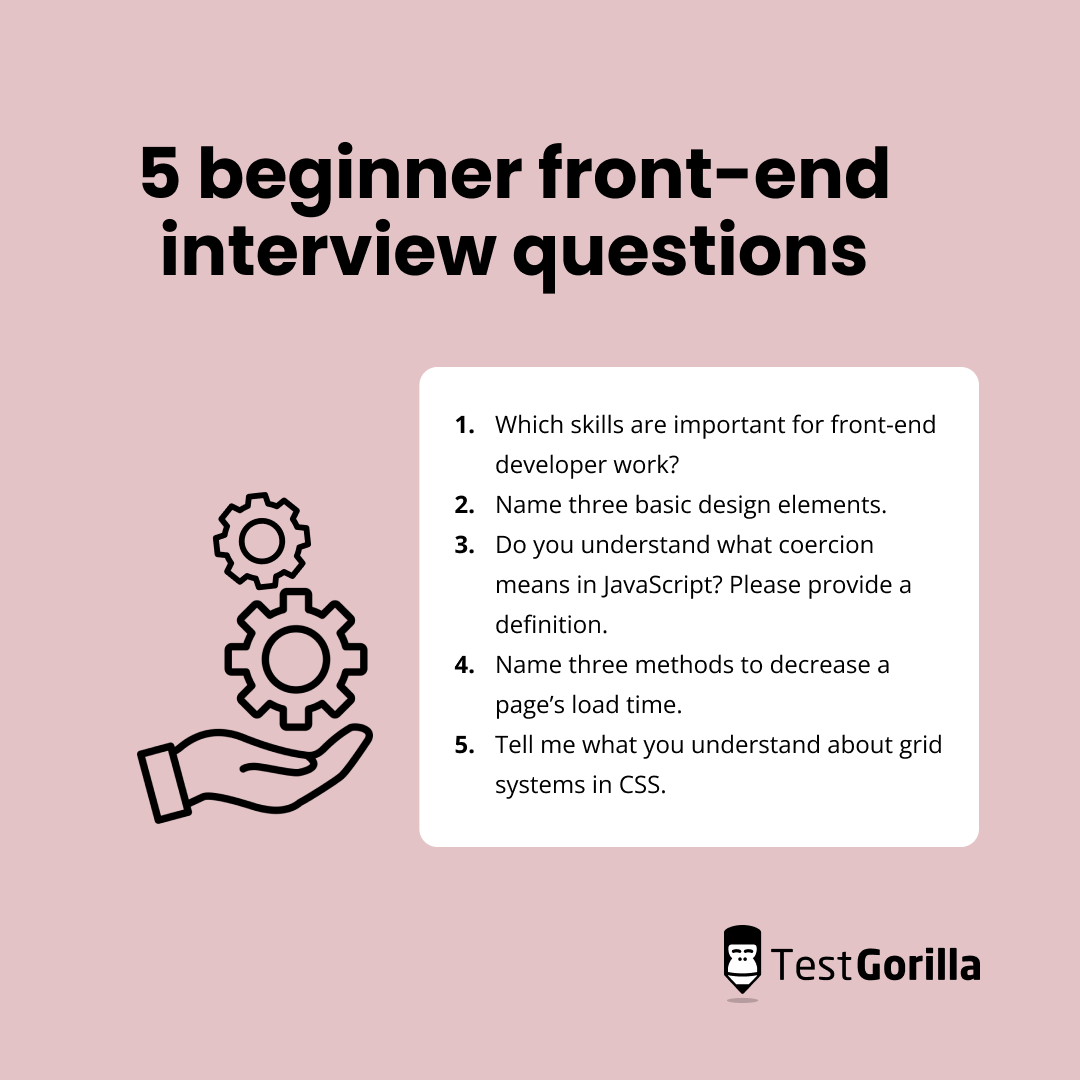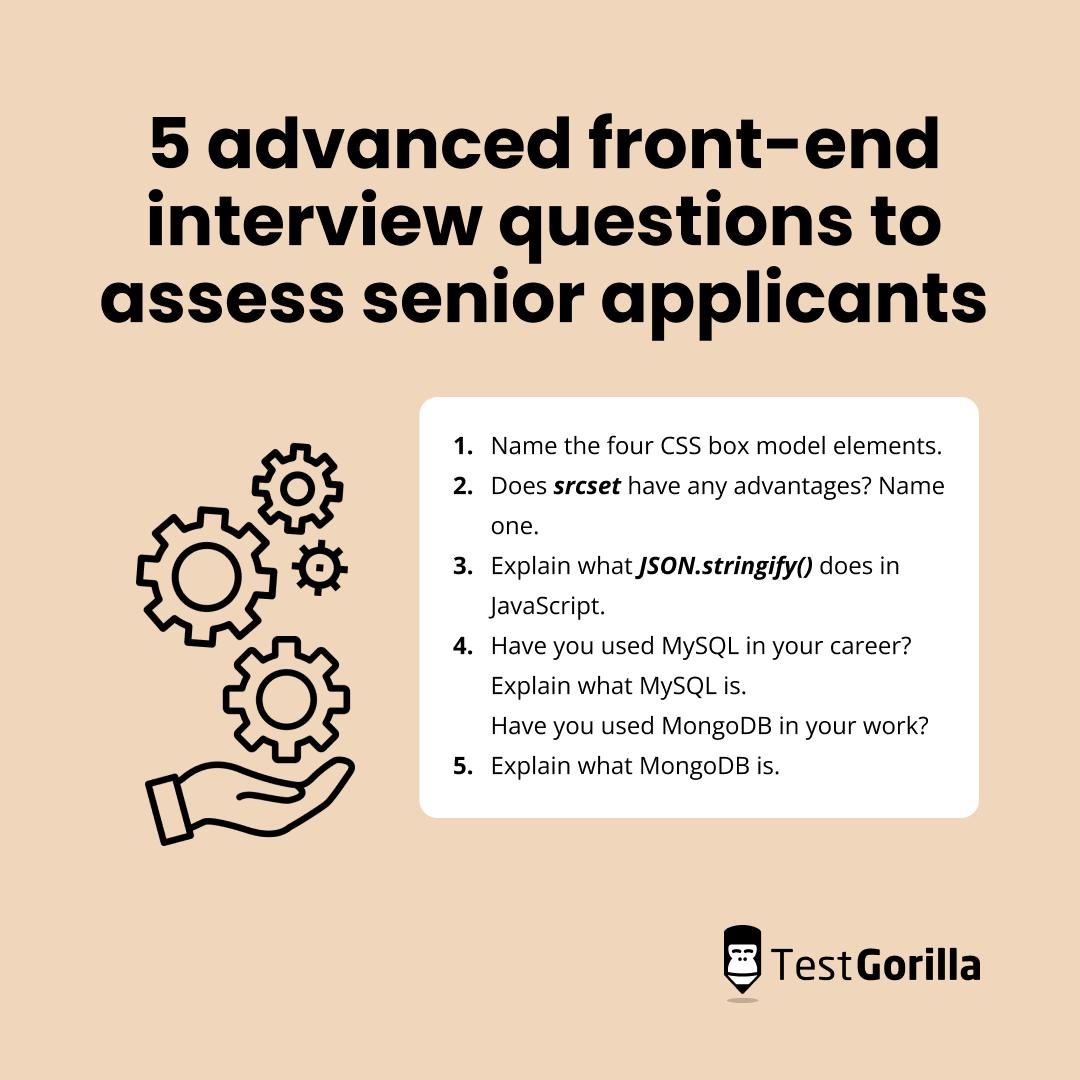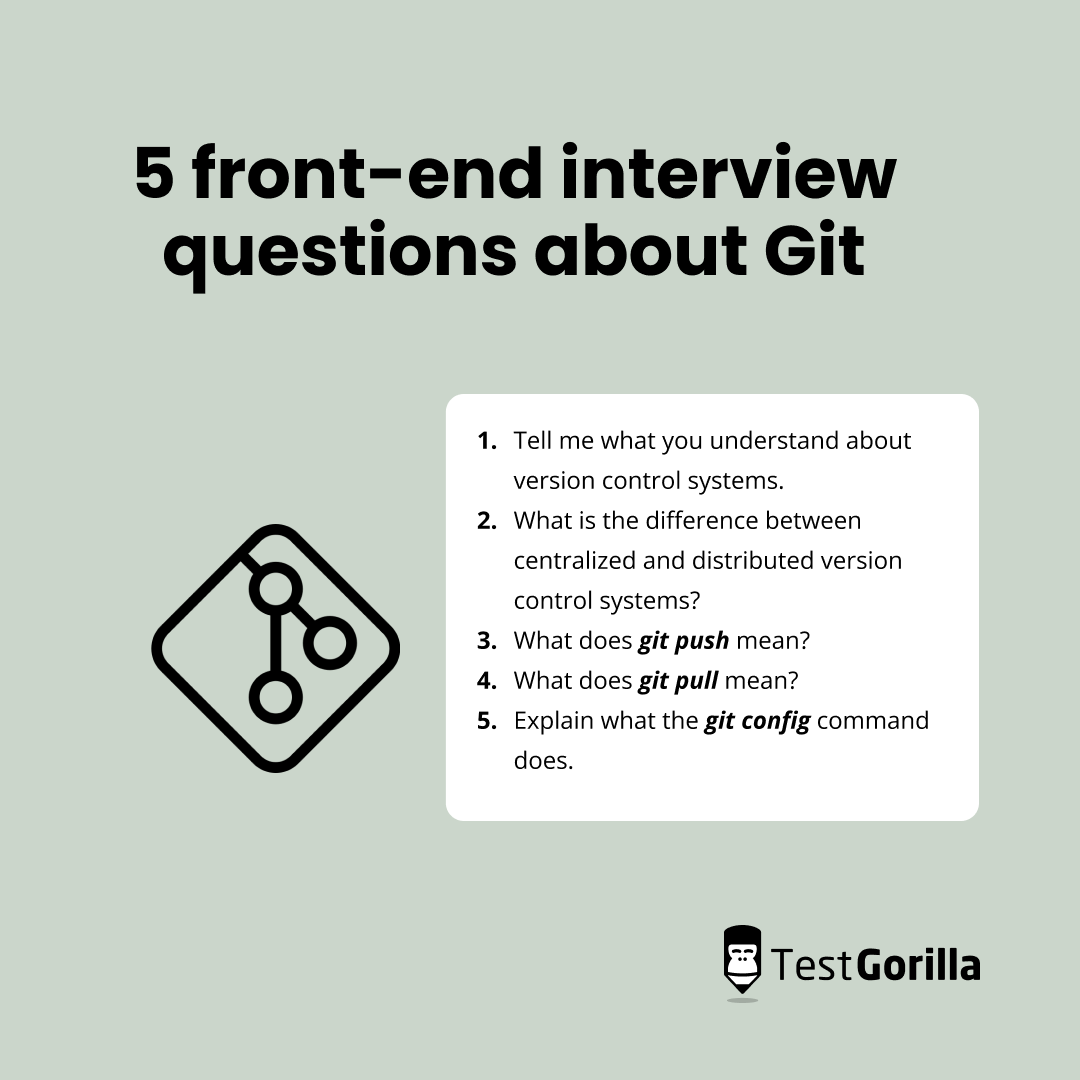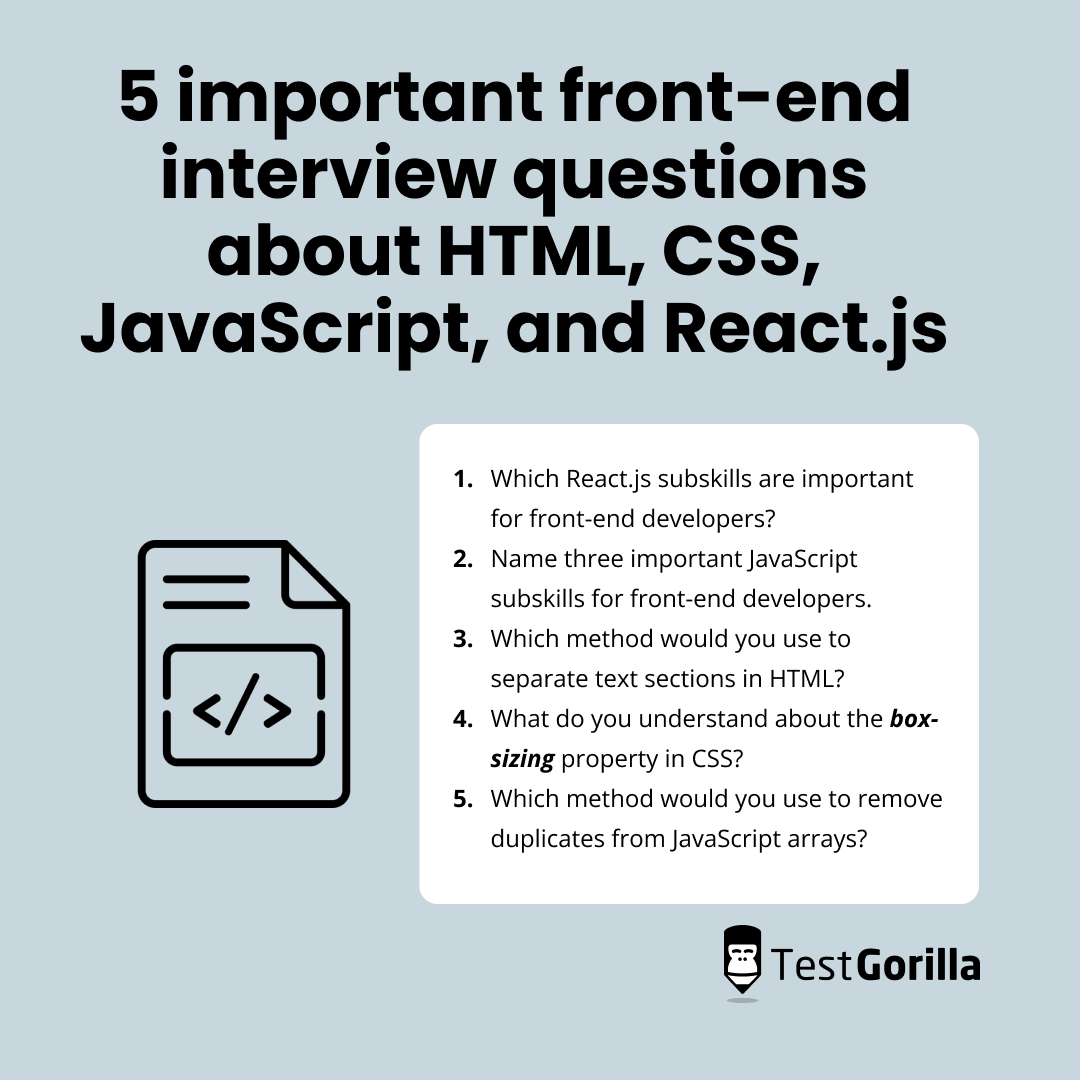75 front-end interview questions to hire professional developers
Choosing the right candidate assessment method is critical if you’re hiring a front-end developer for your team, but the process can be complex and time-consuming. Some methods are unreliable, such as resume screening – you need a strategy that helps you find the right front-end developer for your team and avoid mis-hiring.
What if we told you there are two methods that can help you achieve just that?
Skills testing using programming skills tests and interviewing front-end developers will help you find the best applicants.
That second strategy, interviewing front-end developers, requires you to find the right front-end interview questions before the interview.
But don’t panic. We have gathered 75 interview questions suitable for both junior and senior applicants and technical questions related to Git and essential front-end skills. Build your own list with our questions below.
Table of contents
- 20 beginner front-end interview questions to ask junior candidates
- 5 beginner front-end interview questions and answers
- 5 advanced front-end interview questions and answers to assess senior applicants
- 19 front-end interview questions about Git version control
- 5 front-end interview questions and answers about Git
- 31 front-end interview questions about HTML, CSS, React.js, and JavaScript
- 5 important front-end interview questions and answers about HTML, CSS, JavaScript, and React.js
- What is the best time to use front-end interview questions in the hiring process?
- Assess developers’ knowledge with front-end interview questions
20 beginner front-end interview questions to ask junior candidates
These 20 beginner front-end interview questions are ideal for assessing junior applicants. Ask your candidates some of the questions in this section to review their front-end development knowledge.
1. Explain what meta tags are in HTML.
2. Name three basic design elements.
3. Which skills are important for front-end developer work?
4. Explain what load balancing means.
5. Explain what NPM means.
6. Tell me what you understand about scope in JavaScript.
7. What is the main difference between jQuery and JavaScript?
8. Tell me what you know about Content Security Policy.
9. Define cross-site scripting.
10. Explain what user-centered design means,
11. What do you understand about callbacks in JavaScript?
12. What do you understand about polymorphism?
13. Can you explain what the KISS principle means?
14. Can you explain what the SOLID acronym means?
15. Tell me what you understand about clickjacking.
16. Do you understand what coercion means in JavaScript? Please provide a definition.
17. Explain what IIFE means.
18. Tell me what you understand about grid systems in CSS.
19. Explain what a mixin is.
20. Name three methods to decrease a page’s load time.
5 beginner front-end interview questions and answers
Refer to these five sample answers for some crucial beginner front-end interview questions in this section to check the accuracy of your applicants’ responses.
1. Which skills are important for front-end developer work?
Several skills are important for front-end developer work. From knowledge of HTML to CSS to JavaScript, many technical skills can help front-end developers construct web designs and produce well-structured web pages.
HTML skills help front-end developers structure the website, and CSS skills make it easier to design the layout. Meanwhile, proficiency with the JavaScript programming language enables developers to make a web page’s elements dynamic.
Knowledge of these languages is crucial for any role that involves front-end development: 23% of website project managers include HTML skills on their resume, and 17% include JavaScript skills. However, other skills are important too.
Our HTML, CSS, and JavaScript tests are a quick and simple assessment method to evaluate your applicants’ HTML, CSS, and JavaScript skills more thoroughly. Check these tests to find out the subskills they evaluate, or try our JavaScript test with a free plan.
2. Name three basic design elements.
Applicants should understand the following three basic design elements:
Size: the amount of space a shape occupies
Texture: the shape’s surface texture (which may be smooth, hard, or soft)
Color: the objects’ color, which incorporates values, hues, and intensity
3. Do you understand what coercion means in JavaScript? Please provide a definition.
To test your applicants’ entry-level front-end developer knowledge, consider whether they can define coercion in JavaScript. Skilled candidates will understand that coercion involves converting a value from one data type to another during runtime.
They may also mention two forms of coercion in JavaScript – explicit and implicit.
Implicit coercion occurs when JavaScript automatically converts a data type to another type based on the context in which it is used. Explicit coercion occurs when a developer explicitly converts a value from one data type to another using the language’s inbuilt operators or functions.
4. Name three methods to decrease a page’s load time.
Candidates with entry-level front-end developer knowledge should know from experience how to decrease page load times. Consider whether they can name three methods for improving a page’s loading speed. Below are some techniques they may mention:
Optimizing images
Compressing content
Placing CSS and JavaScript code in external files
Ensuring applicants have this knowledge and skill is important, given that almost 70% of consumers say that page speed affects their willingness to buy products from retailers.
5. Tell me what you understand about grid systems in CSS.
A grid system in CSS is a structure that front-end developers use to arrange content horizontally or vertically on a page. Grid systems reduce the complexity of arranging content consistently and feature two key components – columns and rows.
Put your applicants’ CSS knowledge to the test and determine if they fully understand how this language functions with our CSS skills test.
The best insights on HR and recruitment, delivered to your inbox.
Biweekly updates. No spam. Unsubscribe any time.
5 advanced front-end interview questions and answers to assess senior applicants
If you’re looking for senior front-end developers, these advanced front-end interview questions are ideal for assessing their knowledge. Check the answers below to assess the accuracy of your candidates’ responses.
1. Name the four CSS box model elements.
Senior candidates who have experience with CSS should understand the CSS box model. They may respond by explaining that the CSS box model helps developers create complex layouts and name the four CSS box model elements listed below:
Content
Padding
Borders
Margins
2. Does srcset have any advantages? Name one.
srcset is an HTML attribute that specifies a set of image URLs with different sizes and resolutions. This enables the browser to determine which image source is the most suitable based on factors such as the user’s screen size or pixel density.
One benefit of srcset is that it increases performance and reduces loading times by displaying images that are the appropriate size for the user’s device.
3. Explain what JSON.stringify() does in JavaScript.
Applicants should know that front-end developers use the JSON.stringify() method to convert JavaScript values to JSON strings. This enables them to send and receive these objects more easily. This is particularly important when sending data to a web server since the data must be transmitted as a string.
4. Have you used MySQL in your career? Explain what MySQL is.
If applicants have used MySQL, they will know it’s a relational database management system (RDBMS) that uses the SQL programming language. They may also know MySQL uses a table structure and is the most widely adopted open-source RDBMS.
5. Have you used MongoDB in your work? Explain what MongoDB is.
Candidates with MongoDB experience will understand that this NoSQL database application represents data elements using a document-oriented format called BSON (binary JSON). They may also mention that programmers use the MongoDB query language to make changes in MongoDB.
19 front-end interview questions about Git version control
To evaluate your applicants’ Git version control knowledge, ask them these 19 front-end interview questions.
1. Tell me what you understand about version control systems.
2. What is the difference between centralized and distributed version control systems?
3. What does git push mean?
4. What does git pull mean?
5. Explain what the git config command does.
6. Explain what the git init command does.
7. Explain what the git add command does.
8. Explain what the git diff command does.
9. Explain what the git commit command does.
10. Explain what the git reset command does.
11. Explain what the git status command does.
12. Explain what the git merge command does.
13. What does the git pull command do?
14. What does the git fetch command do?
15. How is git pull different from git fetch?
16. Explain what a merge conflict is in Git.
17. How would you resolve a merge conflict in Git?
18. Tell me what you know about git stash.
19. How is git merge different from git rebase?
5 front-end interview questions and answers about Git
If you need to review your candidate’s responses to the most important Git front-end interview questions, check the sample answers provided here.
1. Tell me what you understand about version control systems.
Programmers can use a version control system to manage changes to files or datasets or restore the data to a previous version. These systems also ensure the entire programming team uses the most recent file or dataset version.
Applicants answering this question should know that version control systems are widely used by development teams: 93% of developers use Git to manage files and datasets.
To assess your applicants’ Git knowledge, you can use our Git skills test, which is available in our skills test library.
2. What is the difference between centralized and distributed version control systems?
Ask candidates this question to put their knowledge of version control systems to the test.
When using centralized version control systems, developers commit changes to one central repository. They tend to be simpler to understand and use than distributed version control systems. However, if the developers lose access to the central repository or it becomes corrupted, it will no longer be usable.
On the other hand, when using a distributed version control system, each developer has a copy of the repository. In this newer approach, each team member’s local copy could be used as a backup. They can also work independently on their copy and commit their changes without requiring access to the central server.
3. What does git push mean?
To determine if your front-end developer candidates have sufficient Git knowledge, ask them this simple front-end interview question.
Applicants with Git experience will know that git push is a command developers use to push contents to upload commits made to their local repository to a remote repository. They may also explain that the required syntax for git push is:
$ git push <option> [<remote URL><name of branch><refspec>…]
4. What does git pull mean?
Programmers use the git pull command to pull changes from a remote repository and merge them with their local copy. This involves first fetching the latest changes from the remote repository and then merging those changes into their current branch.
5. Explain what the git config command does.
Candidates should know that developers use git config to customize how Git functions and looks. In other words, this powerful command enables developers to make changes to Git’s configuration settings.
31 front-end interview questions about HTML, CSS, React.js, and JavaScript
Ask interviewees some of these 31 front-end interview questions about HTML, CSS, React.js, and JavaScript to test their technical knowledge.
1. Explain what an attribute is in HTML.
2. Explain what a marquee is in HTML. Is there a better alternative?
3. Define semantic HTML.
4. How does semantic HTML work?
5. Explain how you would display a table on a web page with HTML.
6. What do you understand about SVG in HTML?
7. Which method would you use to separate text sections in HTML?
8. Which React.js subskills are important for front-end developers?
9. How would you include CSS styling in an HTML document?
10. What do you understand about the box-sizing property in CSS?
11. Which method would you use to hide elements using CSS?
12. Explain what CSS sprites are.
13. Name three data types that JavaScript accepts.
14. Tell me what you know about cookies in JavaScript.
15. Explain what closures are in JavaScript.
16. Explain what exports and imports are in JavaScript.
17. Explain what undefined variables are in JavaScript.
18. Explain what undeclared variables are in JavaScript.
19. Which method would you use to remove duplicates from JavaScript arrays?
20. Explain what JSC is.
21. How does the virtual DOM relate to React.js?
22. Explain what React extensions are.
23. Tell me what you understand about events in React.
24. Explain what components are in React.js.
25. Explain what states are in React.
26. How would you implement states in React.js?
27. Name three important JavaScript subskills for front-end developers.
28. Describe what higher-order components are in React.js.
29. Describe what pure components are in React.js.
30. Which method would you use to implement React routing?
31. Explain what null means in JavaScript.
5 important front-end interview questions and answers about HTML, CSS, JavaScript, and React.js
Consult the following sample answers to these important HTML, CSS, JavaScript, and React.js front-end interview questions to assess your applicants’ knowledge.
1. Which React.js subskills are important for front-end developers?
Front-end developers need various subskills to use the React.js library, from understanding design patterns to React hooks, state management, and advanced React.js concepts.
To build websites or applications with dynamic components, candidates should also understand how React.js facilitates the process. Therefore, you should ask follow-up questions to determine if candidates understand why React.js is important.
If you need statistical data to gauge your applicants’ React.js skills, our React online test is the best option. It will help you assess the critical React.js subskills required for completing complex front-end projects.
2. Name three important JavaScript subskills for front-end developers.
Front-end developers require several JavaScript subskills to add functional features to websites.
Applicants familiar with JavaScript will know that functional programming, cross-browser code writing, and memory management are some subskills that benefit front-end developers. Listen for responses that explain why these skills are important.
For example, applicants may explain that functional programming helps front-end developers avoid data mutation and side effects.
3. Which method would you use to separate text sections in HTML?
This front-end interview question is relatively simple. Most candidates will understand that front-end developers use HTML tags to divide text sections and may name three examples of tags they would use.
For instance, the <br> tag breaks up lines of text, the <blockquote> tag indicates longer quotations, and the <p> tag creates paragraphs of text.
4. What do you understand about the box-sizing property in CSS?
Candidates should respond to this question by explaining that the box-sizing property defines how an element’s width and height are calculated.
They may also describe how the possible values of this property change the box-sizing behavior. Setting the value of box-sizing to content-box specifies that the element’s width and height should be calculated based on only its content box without the padding, border, or margin.
However, setting the value to border-box indicates that the element’s width and height should include the padding and border.
5. Which method would you use to remove duplicates from JavaScript arrays?
One method front-end developers may use to remove duplicates from JavaScript arrays is the filtering technique. This technique involves using three arguments to call the filter() function to create a new array that does not contain any duplicates
Other applicants may prefer using a for loop to store only unique elements in one empty array.
What is the best time to use front-end interview questions in the hiring process?
Interviews, including technical or personal interviews, are best completed after skills testing and before you decide to hire a candidate.
It’s more efficient to use pre-employment testing to create a shortlist of the best front-end developer candidates before the interview stage – it just takes a few seconds to receive the skills test results and check the statistics.
Use the statistical data generated by the skills assessment and your applicants’ responses to the interview questions when you have completed the interviews. This data will help you make an informed, successful hiring decision.
Assess developers’ knowledge with front-end interview questions
Front-end interview questions and skills tests are the ideal strategies for finding developers with the right skills. If you’re an HR professional for a software development organization and don’t have the technical skills to assess front-end developer applicants, use skills tests like our jQuery test to review their abilities first.
Hire software developers who match your business. Try TestGorilla for free, and use our skills tests to review your candidates the simple way.
You've scrolled this far
Why not try TestGorilla for free, and see what happens when you put skills first.


















